
Georg (Göran) Wahlenberg was a Swedish naturalist. He was born in Kroppa, Värmland County.

Verrucariaceae is a family of lichens and a few non-lichenised fungi in the order Verrucariales. The lichens have a wide variety of thallus forms, from crustose (crust-like) to foliose (bushy) and squamulose (scaly). Most of them grow on land, some in freshwater and a few in the sea. Many are free-living but there are some species that are parasites on other lichens, while one marine species always lives together with a leafy green alga.
Clavascidium is a genus of lichens in the family Verrucariaceae. The genus was circumscribed in 1996 by Austrian lichenologist Othmar Breuss. Because the type species of the genus, Clavascidium umbrinum, has been shown using molecular phylogenetics to belong to genus Placidium, Cécile Gueidan and colleagues proposed to unite Clavascidium with Placidium in a 2009 publication. Despite this, the genus has been retained in recent publications of fungal classification.
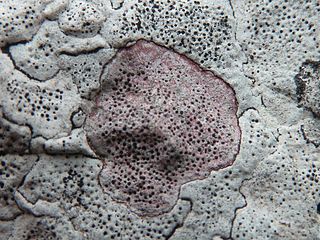
Bagliettoa is a genus of lichen-forming fungi in the family Verrucariaceae. The genus was circumscribed by Italian lichenologist Abramo Bartolommeo Massalongo in 1853. Bagliettoa species are endolithic, growing between the grains of solid rock.

Heteroplacidium is a genus of lichen-forming fungi in the family Verrucariaceae. The genus was circumscribed by Austrian lichenologist Othmar Breuss in 1996 with Heteroplacidium imbricatum assigned as the type species. It was proposed as a segregate of Catapyrenium. Other morphologically similar genera are Neocatapyrenium, Placidium, and Scleropyrenium, although molecular phylogenetic analyses indicate that they are independent monophyletic lineages within the Verrucariaceae.
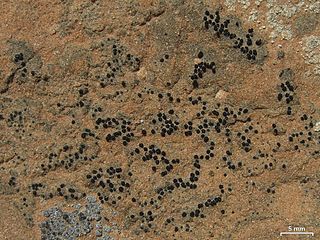
Staurothele is a genus of saxicolous (rock-dwelling), crustose lichens in the family Verrucariaceae. It has about 40 species. When the fungus is part of a lichen, the genus of lichen is commonly called rock pimples.
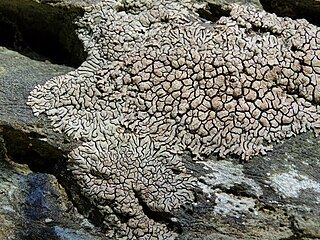
Placopyrenium is a genus of saxicolous (rock-dwelling), crustose lichens in the family Verrucariaceae.
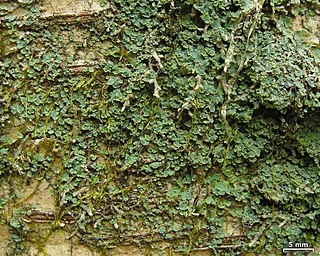
Normandina is a genus of lichen-forming fungi in the family Verrucariaceae. It has five species of crustose and squamulose (scaly) lichens.
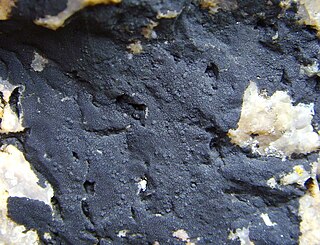
Hydropunctaria maura, still often called by the older name Verrucaria maura and commonly known as tar lichen, is a species of saxicolous (rock-dwelling), crustose lichen belonging to the family Verrucariaceae. A perennial species that does not experience seasonal variations, it is the type species of the genus Hydropunctaria. The medulla is a black basal layer that forms columns to the upper surface and isolates the algae into pockets near the upper surface. The black band formed by H. maura can often be seen at a distance as a marker of the high water point.

Hydropunctaria is a genus of saxicolous (rock-dwelling), crustose lichens in the family Verrucariaceae. The genus includes both aquatic and amphibious species, with members that colonise either marine or freshwater habitats. The type species, Hydropunctaria maura, was formerly classified in the large genus Verrucaria. It is a widely distributed species common to littoral zones. Including the type species, five Hydropunctaria lichens are considered marine species: H. adriatica, H. amphibia, H. aractina, H. orae, and H. oceanica.
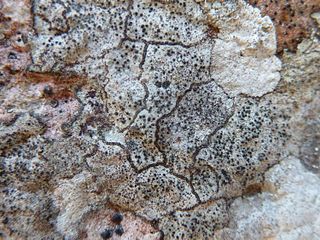
Parabagliettoa is a genus of crustose lichens in the family Verrucariaceae. It has 3 species. The genus was circumscribed in 2009 by Cécile Gueidan and Claude Roux, with Parabagliettoa dufourii assigned as the type species.

Verruculopsis is a genus of saxicolous (rock-dwelling), crustose lichens in the family Verrucariaceae. It was circumscribed in 2007 by Cécile Gueidan, Pere Navarro-Rosinés, and Claude Roux, with Verruculopsis poeltiana assigned as the type species.
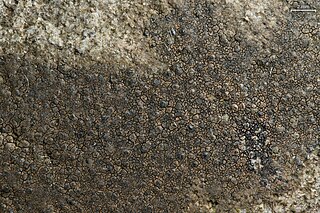
Willeya is a genus of saxicolous (rock-dwelling), crustose lichens in the family Verrucariaceae. It has 12 species. Most species are found in southeast Asia, although individual representatives are known from Australia, Europe, and North America.

Mastodia is a genus of lichen-forming fungi in the family Verrucariaceae. It has six species.
Hydropunctaria rheitrophila is a species of freshwater, saxicolous (rock-dwelling), crustose lichen in the family Verrucariaceae. It was formally described as a new species in 1922 by German lichenologist Georg Hermann Zschacke as a species of Verrucaria. Christine Keller, Cécile Gueidan, and Holger Thüs transferred it to the newly circumscribed genus Hydropunctaria in 2009. It is one of several aquatic lichens that are in this genus. The photobiont partner of Hydropunctaria rheitrophila is a yellow-green alga.
Trimmatothele is a genus of saxicolous (rock-dwelling), crustose lichens in the family Verrucariaceae. It has five species. The genus was formally published by lichenologist Alexander Zahlbruckner in 1903. The type species, Trimmatothele perquisita, was originally collected from Norway by Johannes M. Norman, who placed it in the genus Coniothele in 1868. Diagnostic characteristics of Trimmatothele include a thin thallus with a smooth surface; small perithecia that are partially immersed in the substrata and have an involucrellum; asci that contain multiple ascospores; and small, simple ascospores. Trimmatothele has been described as one of the most poorly known genera of lichens due to the rarity of its species, the few available herbarium specimens, and some missing type specimens.
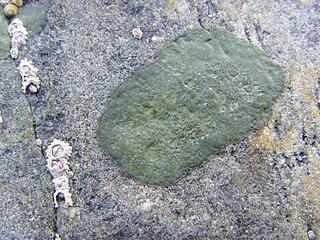
Wahlenbergiella mucosa is a species of saxicolous (rock-dwelling), crustose lichen in the family Verrucariaceae. It is a marine species that grows in the littoral zone, and therefore remains immersed in seawater for extended periods. Its photobiont partner is the green alga Paulbroadya petersii.
Wahlenbergiella tavaresiae is a species of saxicolous (rock-dwelling), crustose lichen in the family Verrucariaceae. Known from several locations in the San Francisco Bay area of the United States, it is a marine lichen that inhabits intertidal zones, and as such is immersed in seawater on a regular basis. Associated algal species include the red algae Hildenbrandia and Mastocarpus papillatus, and the brown algae Pelvetiopsis and Fucus. Petroderma maculiforme, a brown alga, is the photobiont partner in the lichen.
Cécile Gueidan is a mycologist and lichenologist who applies morphological and molecular biological methods to the origin and taxonomy of fungi that live in lichen symbioses and within rocks.

Hydropunctaria amphibia is a species of saxicolous (rock-dwelling), crustose lichen in the family Verrucariaceae. One of several marine lichens in the genus Hydropunctaria, is widely distributed across Europe, extending from Norway to the Mediterranean and the Iberian coasts, and has a nearly ubiquitous presence along the Catalan coast of Spain. In North America, it is found along the Atlantic Coast from Nova Scotia to the Boston Harbor islands, where its presence in low-pollution areas indicates its potential as a bioindicator for marine lichen community health, and on the west coast in British Columbia, particularly in the Gwaii Haanas's upper littoral fringe. The black, crust-like thallus grows on seashore rocks – both siliceous rocks and limestone – in the lower supralittoral zone, an area also known as the splash zone. Originally described more than two centuries ago as a species of Verrucaria, Hydropunctaria amphibia sets itself apart from other species in Hydropunctaria through the distinct shape of the perithecium apex, which is either flat-topped or scalloped, in contrast to the typically rounded or immersed apex seen in its relatives.















